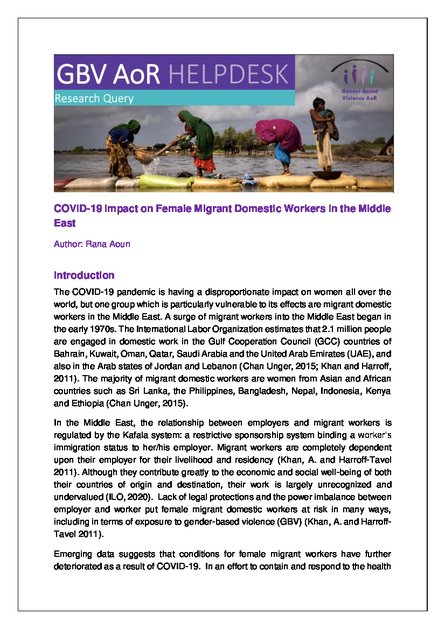
The COVID-19 pandemic is having a disproportionate impact on women all over the world, but one group which is particularly vulnerable to its effects are migrant domestic workers in the Middle East. A surge of migrant workers into the Middle East began in the early 1970s. The International Labor Organization estimates that 2.1 million people are engaged in domestic work in the Gulf Cooperation Council (GCC) countries of Bahrain, Kuwait, Oman, Qatar, Saudi Arabia and the United Arab Emirates (UAE), and also in the Arab states of Jordan and Lebanon (Chan Unger, 2015; Khan and Harroff, 2011). The majority of migrant domestic workers are women from Asian and African countries such as Sri Lanka, the Philippines, Bangladesh, Nepal, Indonesia, Kenya and Ethiopia (Chan Unger, 2015).
In the Middle East, the relationship between employers and migrant workers is regulated by the Kafala system: a restrictive sponsorship system binding a worker’s immigration status to her/his employer. Migrant workers are completely dependent upon their employer for their livelihood and residency (Khan, A. and Harroff-Tavel 2011). Although they contribute greatly to the economic and social well-being of both their countries of origin and destination, their work is largely unrecognized and undervalued (ILO, 2020). Lack of legal protections and the power imbalance between employer and worker put female migrant domestic workers at risk in many ways, including in terms of exposure to gender-based violence (GBV) (Khan, A. and HarroffTavel 2011).
Emerging data suggests that conditions for female migrant workers have further deteriorated as a result of COVID-19. In an effort to contain and respond to the health crisis, GCC countries, Jordan and Lebanon are implementing strict social distancing measures (Goldstein, E. and Braunschweiger, A., 2020). Some countries like Saudi Arabia, Jordan and Lebanon have adopted an aggressive approach towards the virus, such as reinforcing lockdowns and curfews. This has a number of implications for female migrant domestic workers, not only related to their basic health and safety, but also in terms of their exposure to GBV, both in their work environments, and in the larger community.
This report details some of the impacts of COVID-19 on female migrant domestic workers in the Middle East. It looks first at the implications of the Kafala system in relation to the general health and well-being of female migrant domestic workers under COVID-19. The report then examines more specifically female migrant workers’ heightened risk of GBV under COVID-19, as well as the challenges female migrant domestic workers have in accessing essential services. The report concludes with several recommendations for organizations to mitigate risks and safely respond to needs of female migrant domestic workers in the context of COVID-19.
Additional resources are included at the end of the document.